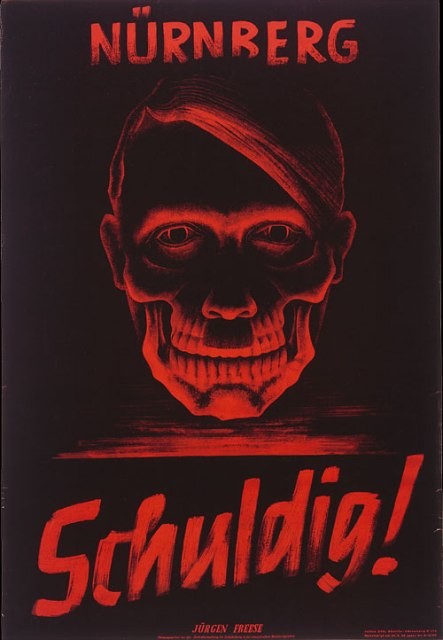
Assessing Guilt
“We gave the Nazis what they denied their opponents… the protection of the law.”
—Former US Secretary of War Henry Stimson describing the International Military Tribunal held at Nuremberg, Germany

When the war in Europe ended in May 1945, the Allies faced the daunting task of reforming German society and reeducating its population after twelve years of Nazi rule and a steady diet of hate propaganda. “Nazism,” as German Jewish writer Victor Klemperer wrote in 1946, had “permeated the flesh and blood of the people through single words, idioms, and sentence structures which were imposed on them in a million repetitions and taken on board mechanically and unconsciously.”
The Allies forced Germans to confront their recent past by exposing the criminality of the Nazi regime through prosecution of the nation's leaders and by eradicating the vestiges of the Führer cult and Joseph Goebbels's propaganda. For the first time in history, war crimes courts tried propagandists—individuals whose spoken words, images, and writings had contributed to Nazi aggression, persecution, and mass murder.
International Military Tribunal: An Unprecedented Trial
During the war, the Allies repeatedly warned Germany and the other Axis powers of their determination to punish those government, military, or Nazi Party officials responsible for criminal actions.
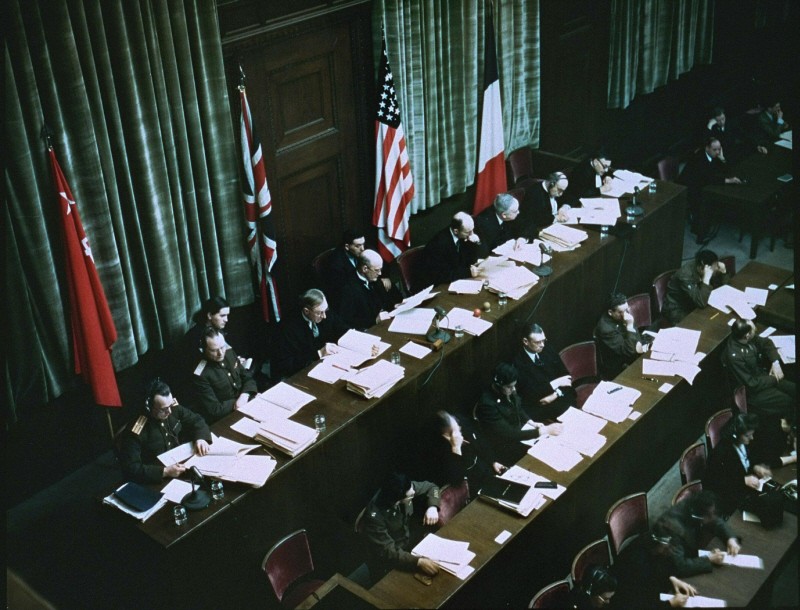
The International Military Tribunal opened in Nuremberg on November 20, 1945. By publicizing the trial of the top Nazi leaders to the German population, the Allies hoped to discredit the Hitler regime and expose the scope of aggression and mass murder. Two hundred fifty journalists from across the globe were present at the Palace of Justice. To make sure that the German population received news of the trials, the Allied occupation authorities increased the newsprint allotment for the German press, and for the duration of the trial, radio stations broadcast reports with commentary several times each day. Beginning on December 7, 1945, newsreels carried regular reports about the trial to the global movie-going audience.
In many respects, the proceedings at Nuremberg were unprecedented. Never had so many national leaders been tried by a court made up of their military conquerors. Twenty-four individuals, representing all sectors of political life under Nazi rule, were indicted on four counts: Common plan or Conspiracy to commit crimes against peace; Crimes against peace; War crimes; Crimes against humanity.
Among the defendants were two individuals linked to the creation or dissemination of Nazi propaganda. The cases against Der Stürmer's editor Julius Streicher, and Ministry of Public Enlightenment and Propaganda official Hans Fritzsche rested entirely upon their actions as propagandists. The indictment included the statement that propaganda was
“one of the strongest weapons of the conspirators [who] from the outset…appreciated the urgency of the task of inculcating the German masses with the National Socialist principles and ideology,” and who used propaganda “to prepare the ground psychologically for political action and military aggression.”
Is There a Link Between Words and Actions?
The key challenge that the prosecution faced in its cases against Streicher and Fritzsche was to prove a direct, causal link between the activities of Nazi propagandists and the implementation of a policy of aggression or mass murder. Is there really a direct link between words and actions?
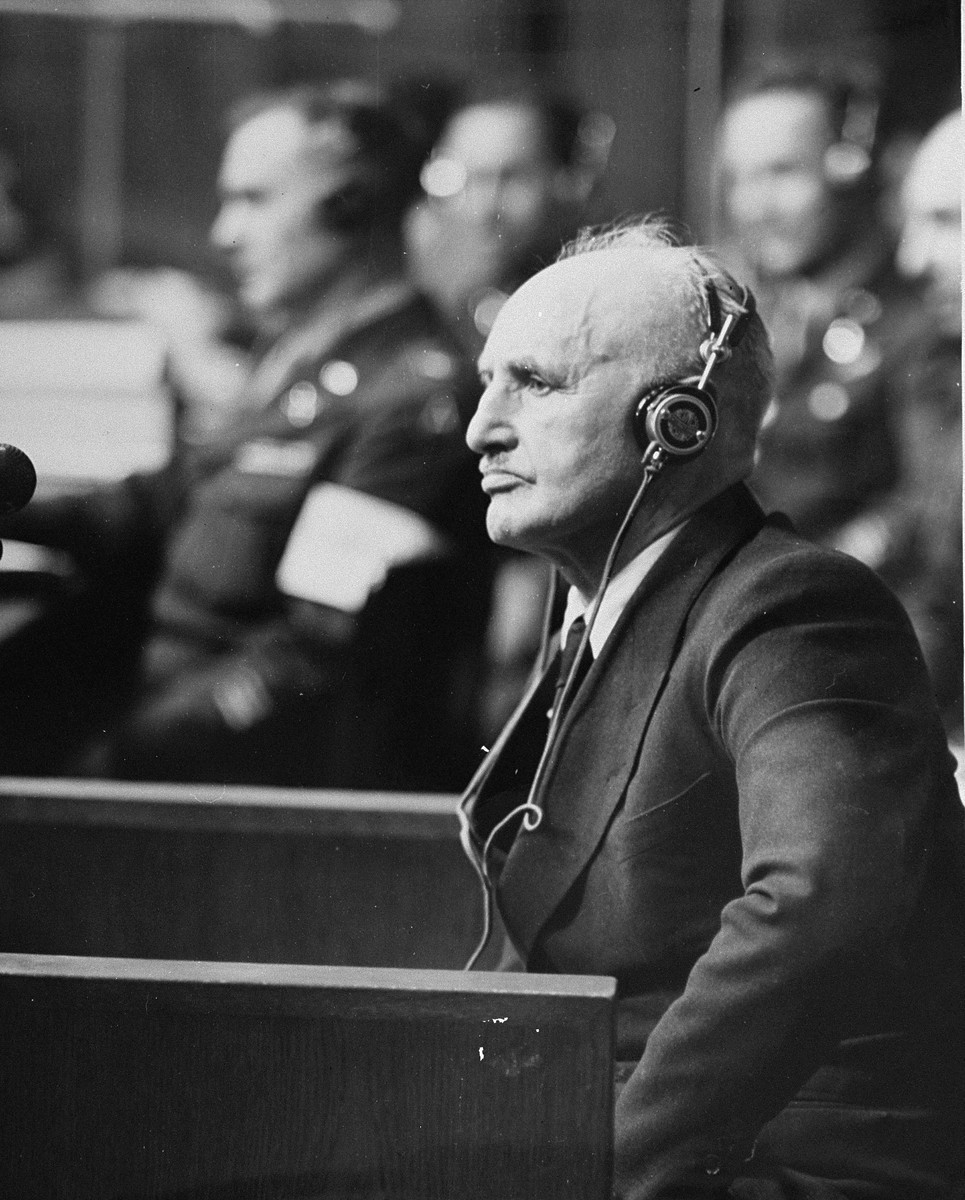
The Streicher case proved the stronger of the two: the twenty-two-year run of Der Stürmer provided ample evidence of Streicher's fanatical hatred for Jews and calls for action against them. The tribunal found Streicher guilty on the charge of crimes against humanity, concluding that twenty-three articles published in Der Stürmer between 1938 and 1941 had called for the extermination of the Jews. The main evidence used to establish Streicher's knowledge of the “Final Solution” was his subscription to a Swiss Jewish newspaper, Israelitische Wochenblat (Israelite Weekly), which published reports of Nazi killings.
The court ruled that
“Streicher's incitement to murder and extermination at the time when Jews in the East were being killed under the most horrible conditions clearly constitutes persecution on political and racial grounds in connection with War Crimes, as defined by the Charter, and constitutes a Crime against Humanity.”
The tribunal sentenced Streicher to death by hanging. At 2:12 a.m. on October 16, 1946, he was led to the gallows and hanged. Postwar trials affirmed the important role that propaganda played in maintaining popular support for the Nazi regime and in justifying the persecution of Jews and other victims of the Holocaust era. The prosecution of propagandists for “crimes against humanity” established an important precedent invoked by international bodies and courts to the present day.
Denazification
Long before the war ended, the Allies pledged to destroy German militarism and Nazism. Following Germany's defeat in May 1945, the occupation authorities began implementing that war aim. At the Potsdam Conference (July–August 1945), the victorious nations laid down the fundamental principles for Germany's reformation: the nation was to be completely disarmed and demilitarized; its armed forces abolished, and its population “de-nazified” and re-educated.
During the immediate postwar period in Allied-occupied Germany, “denazification” entailed renaming streets, parks, and buildings that had Nazi or militaristic associations; removing monuments, statues, signs, and emblems linked with Nazism or militarism; confiscating Nazi Party property; eliminating Nazi propaganda from education, the German media, and the many religious institutions which had pro-Nazi leaders and clergymen; and prohibiting Nazi or military parades, anthems, or the public display of Nazi symbols.
Allied soldiers, former concentration camp prisoners, and anti-Hitler Germans took their vengeance on Nazi symbols by burning or destroying swastika-emblazoned flags, banners, and posters. In a moment captured on film, US soldiers blew up the huge swastika at the Nuremberg stadium, the site of former Nazi rallies.
To those who witnessed it, whether in person or in newsreels shown at movie theaters, the explosion symbolized the end of Nazism and the beginning of a new era. The Führer cult had to be discredited, and the former German leader was shown to have been a maniacal mass murderer whose policies had brought misery to millions of Europeans and had led to the destruction of Germany. Film crews documented workers as they took sledge hammers to a massive metal bust of Hitler and melted down the lead printing plates for his autobiography, Mein Kampf, to produce type for a democratic newspaper for the new Germany. The distribution of Nazi propaganda continues to be illegal in Germany today.
Accepting Guilt
Ordinary Germans following postwar trials of propagandists saw how media figures like Julius Streicher, in order to avoid the hangman's noose, or filmmaker Leni Riefenstahl, in order to save her career and reputation, failed to take responsibility for their involvement in Nazi crimes and demonstrated little remorse. Hans Fritzsche's statement as a defendant at Nuremberg was the exception:
“After the totalitarian form of government has brought about the catastrophe of the murder of 5 millions, I consider this form of government wrong even in times of emergency. I believe any kind of democratic control, even a restricted democratic control, would have made such a catastrophe impossible.”
The former radio broadcaster concluded, “He who, after Auschwitz, still clings to racial politics has rendered himself guilty.”
It would take new generations of Germans, including scholars, born after the war and active in the last three decades of the twentieth century, to raise questions about the behavior of their parents and grandparents during the Nazi years.
Streicher
The Nuremberg prosecutors found it difficult to prove Streicher's knowledge of and personal responsibility for the implementation of the “Final Solution.” An article written for Der Stürmer on November 4, 1943, suggested knowledge:
“It is actually true that the Jews have so to speak disappeared from Europe and that the Jewish 'Reservoir of the East,' from which the Jewish pestilence has for centuries beset the peoples of Europe, has ceased to exist. But the Führer of the German people at the beginning of the war prophesied what has now come to pass.”
Testifying in his own defense, Streicher insisted that he only learned of the mass killings when he was imprisoned by the Allies. He also claimed that his speeches and articles did not aim to incite the Germans but only “to inform” and “enlighten” them “on a question which appeared to me one of the most important questions.” Streicher, whom psychiatrists had evaluated as sane but obsessed with hatred for “the Jews,” came off as insincere and untrustworthy.
In closing arguments in the Nuremberg courtroom, the prosecution detailed the accused's guilt:
“The defendant Streicher is an accessory to the persecution of the Jews within Germany and in occupied territories which culminated in mass murder of an estimated six million men, women, and children. The propaganda in Der Stürmer and other Streicher publications, for which he had admitted responsibility, was of a character calculated to stir up fanatic fear and hatred of the Jewish people and to incite to murder. It was disseminated, moreover, in a country in which there was no free market of ideas; in which, in fact, as defendant Streicher well knew and approved, no countervailing argument could find public expression; and in which, therefore, the impact of such propaganda was of a clearly foreseeable and peculiarly sweeping force. Through propaganda designed to incite hatred and fear, defendant Streicher devoted himself, over a period of twenty-five years, to creating the psychological basis essential to carrying through a program of mass murder. This alone would suffice to establish his guilt as an accessory to the criminal program of extermination.”
Unable to prove a causal link between Streicher's propaganda activity and the actual implementation of mass murder, the prosecution settled for the argument that Streicher actively “recommended and promoted the program of extermination” while mass murder was being committed.
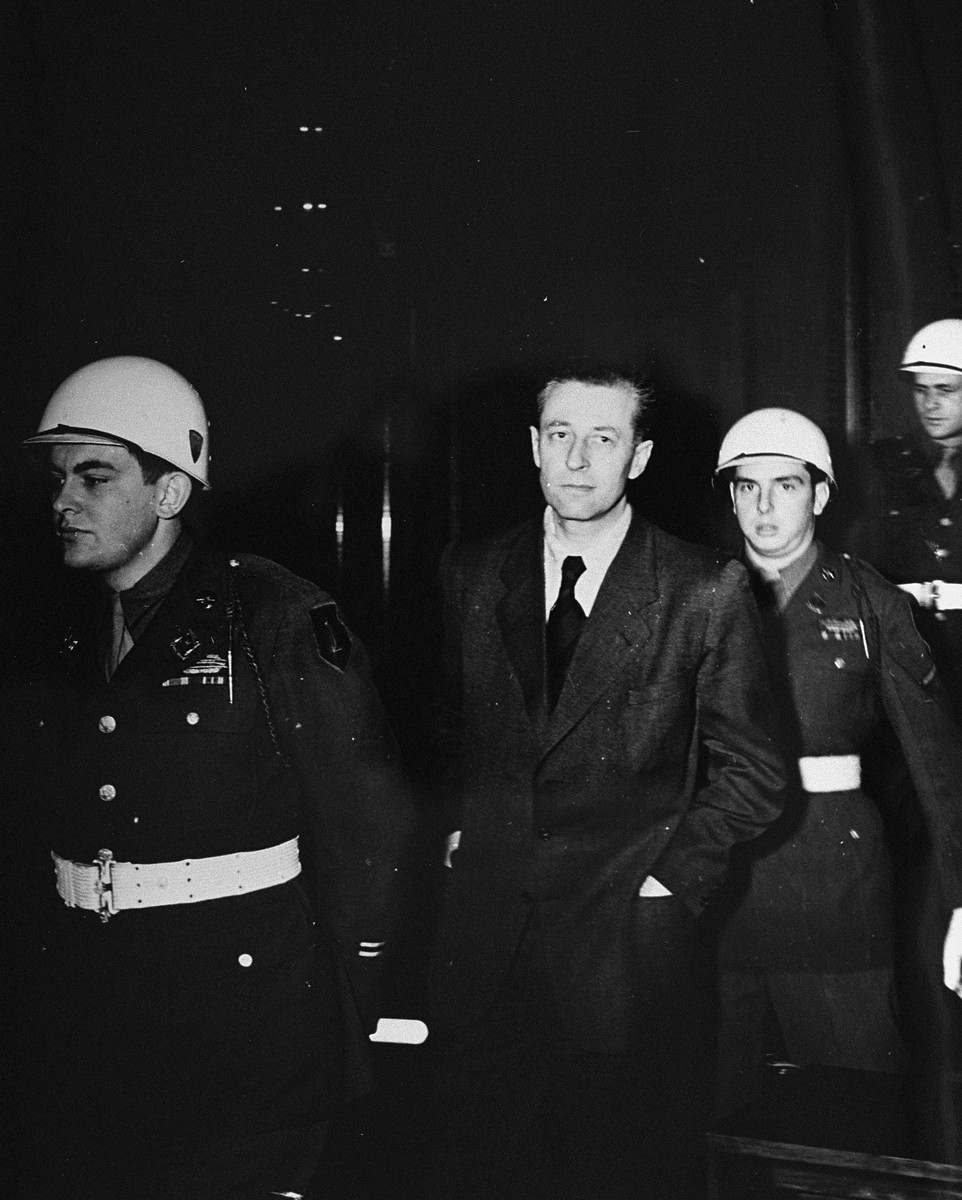
Fritzsche
Hans Fritzsche of the Propaganda Ministry was the lowest ranking German official tried by the International Military Tribunal. Fritzsche probably ended up on the docket with the more senior German officials because Propaganda Minister Joseph Goebbels's death left the Allies without a defendant to represent the Ministry of Public Enlightenment and Propaganda. Additionally, the western Allies were eager to appease the Soviets by selecting Fritzsche, one of only two Nuremberg defendants in Soviet custody in 1945. He had served as director of the Propaganda Ministry's Radio Division and hosted his own broadcast program, Hier Spricht Hans Fritzsche! (Hans Fritzsche Speaks!).
The prosecutor in Fritzsche's case tried to prove the defendant's guilt by drawing on the blatant antisemitic statements from his many broadcasts, which the BBC had intercepted and translated into English. “Fritzsche is not in the dock as a free journalist,” the prosecuting attorney argued,
“but as an efficient, controlled Nazi propagandist . . . who helped substantially to tighten the Nazi stronghold over the German people [and] who made the excesses of these conspirators more palatable to the consciences of the German people themselves.”
The court did not find the evidence convincing and found Fritzsche not guilty on all three counts against him. “It appears that Fritzsche sometimes made strong statements of a propagandist nature in his broadcasts,” the court concluded. “But the Tribunal is not prepared to hold that they were intended to incite the German people to commit atrocities on conquered peoples, and he cannot be held to have been a participant in the crimes charged. His aim was rather to arouse popular sentiment in support of Hitler and the German war effort.”
The court's findings in the Fritzsche case established an important distinction by distinguishing between hate speech or hate propaganda and incitement. Although he made antisemitic broadcasts and statements during his tenure in office, Fritzsche did not specifically call for the mass murder of Europe's Jews. This clearly separated his propaganda from that of his co-defendant Julius Streicher. (Only the Soviet judge, Major General I. T. Nikitchenko, dissented: “The dissemination of provocative lies and the systematic deception of public opinion were as necessary to the Hitlerites for the realization of their plans as were the production of armaments and the drafting of military plans.”)
Fritzsche was later deemed to be a category one “major offender” by the Nuremberg denazification court and sentenced to nine years' imprisonment in a labor camp. Though banned from writing for life, he penned his memoirs while imprisoned and published them under a pseudonym. After his sentence was reduced and he was released in 1950, Fritzsche worked in advertising and public relations until 1953, when he died of cancer at the age of 53.
Additional Propagandists on Trial
Postwar Allied prosecutions of Nazi propagandists continued after the International Military Tribunal, but the mixed results of the subsequent trials did little to clarify the legal problem of linking words and actions. In addition to the US Military Tribunal conviction of former Reich Press Chief Otto Dietrich, German "denazification" courts tried and convicted Nazi press baron Max Amann, film director (Der ewige Jude) Fritz Hippler, and Der Stürmer cartoonist Philipp Ruprecht (known to readers as "Fips"). Other propagandists were acquitted, including film director (Triumph of the Will) Leni Riefenstahl.
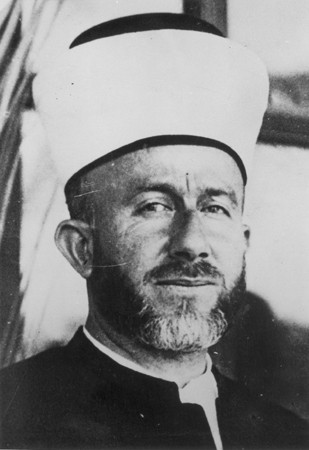
A British court convicted US-born William Joyce (Lord Haw Haw) of treason for his broadcasts of Nazi propaganda and he was executed. The former Mufti of Jerusalem, Hajj Amin al-Husayni, who had broadcast pro-Axis propaganda on the radio from Berlin to the Arab world, was arrested in 1945 in the French occupied zone of Germany. He fled to Egypt, where he continued to produce and disseminate anti-Zionist, anti-Jewish, and anti-Israel propaganda.
For the First Time in History
For the first time in history, war crimes courts tried propagandists—individuals whose spoken words, images, and writings had contributed to Nazi aggression, persecution, and mass murder. Postwar trials affirmed the important role that propaganda played in maintaining popular support for the Nazi regime and in justifying the persecution of Jews and other victims of the Holocaust era. The prosecution of propagandists for "crimes against humanity" established an important precedent invoked by international bodies and courts to the present day.
Critical Thinking Questions
Is there really a direct link between words and actions? Can words and images inspire people to commit acts of genocide?
How did Fritzsche and Striecher justify their actions at the IMT?
How can propaganda be a warning sign for mass atrocity and genocide?
How can knowledge of the events in Germany and Europe before the Nazis came to power help citizens today respond to threats of genocide and mass atrocity?

